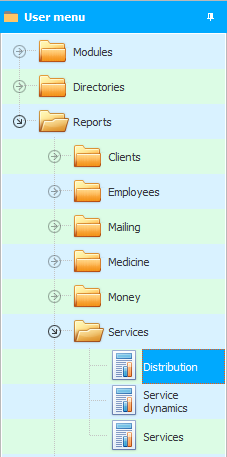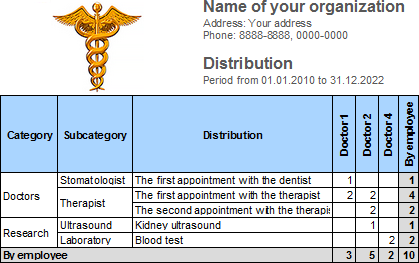

Often the client's impression of the provision of a certain procedure depends on the employee who performed this procedure. You can control the performers of each service using the report "Service distribution" . It will show the distribution of work among employees.

With the help of this analytical report, you can find out who puts more effort into certain jobs. You will also see how evenly services are distributed among specialists. Or, one employee pulls an unbearable burden, while others only create the appearance of active work. This will make it easier to calculate questions about changing shifts or wages. Or decide how it will be necessary to change the shifts of other employees when one specialist goes on vacation.

You can generate a report for any period: both for a month, and for a year, and for another desired period.
Analytics is displayed according to the categories and subcategories you specified in the service catalog. Therefore, it is often important to conveniently distribute services into the right groups so that it is easier for you to evaluate them in various reports.
Further, for each service, it is shown which of the employees provided it and how many times in a given period of time.
For each service there is a summary of how many times it was provided. For each employee there is a total of how many services he provided for the period.
The report is automatically scaled when adding new services and new employees.
Like other reports, it can be printed or downloaded in one of the electronic formats, such as MS Excel, if you are using the 'Professional' version. This will help you edit the report in a convenient way if you need to leave only the services rendered for a certain category.

![]() You can also find out which employees bring in more money to the organization.
You can also find out which employees bring in more money to the organization.
If you want to look at the number of services for each employee from a different 'angle', you can use the 'Volume' report and the 'Dynamics by Services' report if it is more important for you to estimate the number of services for each month of the period without taking into account the breakdown by employee.
See below for other helpful topics:
![]()
Universal Accounting System
2010 - 2025